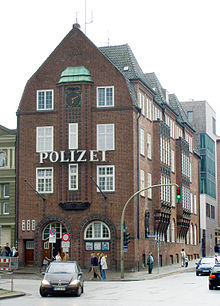Hamburg Police
The State Minister for the Interior (German: Senator für Inneres) oversees the Hamburg Police, which consists of aviation, water, road and port patrols, and crime investigation.After the First World War, riots and civil disorder caused the reinforcement of the police with soldiers and militia.All units took repressive measures against the civil population or were in combat against the regular Polish army, guarded prisoner-of-war camps, participated in drumhead courts-martials, performed with the SS the so-called resettlement of the native populations, executed the so-called hostages, and carried out Jew hunts and mass shootings.[9] For example, on 13 July 1942, the Hamburg Reserve Police Battalion 101 companies stationing in Zamość, Biłgoraj, Radzyń Podlaski and later in Łuków County, under the command of Major Wilhelm Trapp executed 1,500 Polish Jews, men, women and children in the forest near Józefów, Biłgoraj County.[10] On 19 August 1942, the 2nd company of Battalion 101 executed in a mass shooting action some 1,700 Jewish people from Łomazy according to German documents, aided by Ukrainian Hilfswillige known as Trawnikis.[10] After the war, Trapp and several others were investigated by British authorities and Polish Military Mission and extradited to Poland in 1946.Since the 1980s the Hamburg State Ministry of the Interior researched the history of the police force during the Weimar Republic and Nazi Germany.In 1945 head of the police was the British Colonel Michel O'Rorke, chief of the Public Safety Branch.Units are among others the Criminal Investigation Services (Kriminalpolizei), the Special Task Force (Spezialeinsatzkommando) Special Weapons and Tactics Unit and Mobile Surveillance Task Force (Mobiles Einsatzkommando) The Polizeiverkehrskasper, is a Punch used in kindergartens to educate children since 1948.Law enforcement in general under the oversight of the prosecutor, prosecution of infractions, traffic control, and administrative assistance are also tasks.Its tasks are defined in the Gesetz zum Schutz der öffentlichen Sicherheit und Ordnung (SOG)[22] — the state law of the protection of security and order — for acts to avert danger, and the Federal Strafprozeßordnung (StPO) (Code of criminal procedure),[23] for the law enforcement itself.(in German)) selling T-shirts;[26] Jürgen Roland's 1960 film Polizeirevier Davidwache describes the work at the police station;[27] also the film Fluchtweg St. Pauli — Großalarm für die Davidswache (International title: Hot Traces of St. Pauli, UK: Jailbreak in Hamburg) (1971) featured the station;[28] the documentary Meine Davidwache from 2008;[29] and the book Einsatz auf St. Pauli Geschichten aus der Davidwache by Ingeborg Donati and Thomas Mettelmann describe the all-day work of police officers.One is located at the mouth of the Elbe river in Cuxhaven, Lower Saxony, and another is a sub-station in Lauenburg, a town in Schleswig-Holstein.[5] In 1997 the government of Hamburg decided to build a new headquarters at the area of the stand-by police in Alsterdorf quarter.The financing model for police equipment was new to Germany, private economy granted a passive credit to the government of Hamburg, so all uniforms could be changed at once.[35] Hamburg's Polizeieinsatzfahrzeuge — the formal name for patrol cars — are called "Peterwagen", because of a misunderstanding between a German clerk and a British officer.[36] The Hamburg Police has often been criticized for single incidents like arrests, conduct during demonstrations, or false radar speed checks.On 8 June 1986, the Hamburg Police closed in on 861 protesters and contained them in the open area of the Heiligengeistfeld for 13 hours.The 4 police leaders of the Hamburg pocket were declared guilty of deprivation of personal freedom, but only admonishment and had to pay a fine.[39] In 1994 a Parlamentarischer Untersuchungsausschuss (PUA) (parliamentary commission of enquiry) was installed after the resignation of the State Minister for the Interior Werner Hackmann, because of several accusations of xenophobia, with assaults and alleged police brutality.The State Office for the Protection of the Constitution (Landesamt für den Verfassungsschutz) is Hamburg's domestic intelligence agency.[24] A company of the German military police (4./FJgBtl 151) is stationed at the Reichspräsident-Ebert-Kaserne (Imperial President Ebert barracks) in the Altona borough.



































HamburgGovernment of HamburgHamburg HauptbahnhofLauenburgCuxhavenAlsterEurocopter EC 135Ernst UhrlauGermanLandespolizeicity-stateLaw enforcement in Germanypolice stationsSchutzpolizeiHistory of HamburgSchutterijAmsterdammilitaryConstablerslabour movementriflesBerlinFirst World WarGerman Revolution of 1918–1919OrdnungspolizeiKapp PutschNazi GermanyGleichschaltungarmed forcesAustriaSudetenlandannexation of Austriainvasion of PolandPolandKielceKońskieReserve Police Battalion 101ZamośćBiłgorajRadzyń PodlaskiŁuków CountyWilhelm TrappPolish JewsJózefów, Biłgoraj CountyŁomazyTrawnikisWeimar RepublicBritish occupationMax BrauerHelmut SchmidtdenazificationNorth Sea flood of 1962Public Safety BranchGestapoSocial Democratic Party of GermanyBritish Military GovernmentBereitschaftspolizeiHarburg HillsLandeskriminalamtWasserschutzpolizeiLandesbereitschaftspolizeiSpezialeinsatzkommandoits own museumepaulettesBeamterhatbandpeaked capWeichmannAsia–Europe MeetingHarley-DavidsonDragonflyMercedes-Benz E-ClassBMW 3 SeriesPolice captainPolice sergeantexecutivepublic securityprosecutorinfractionslegal jurisdictionReeperbahnboroughs and quarters of HamburgKurt Schumacherred light districtJürgen RolandLower SaxonySchleswig-HolsteinNeuer WallskyscrapersAlsterdorfWalther P5Heckler & Koch P2000 V2Heckler & Koch MP5Ronald SchillHamburg city hallclosed inHeiligengeistfeldChernobyl disasterBrokdorf Nuclear Power Plantanti-nuclear movementsolatiumxenophobiapolice brutalityWorld War IIFederal PoliceHamburg AirportGerman military policeImperial PresidentAltonaPolice Community Support Officersboroughs of HamburgBrowning, ChristopherDaniel Jonah GoldhagenChristopher R. BrowningDie WeltBundesministerium der JustizteNeuesHamburger MorgenpostHamburger AbendblattNorddeutscher RundfunkDie TageszeitungStreitkräftebasisHamburg-MitteFree and Hanseatic City of HamburgGovernmentParliament
